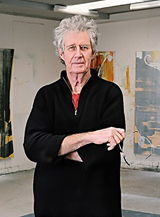

John Firth-Smith was born in Melbourne. Shortly after his birth, his family moved to a seaside suburb in Auckland, New Zealand. A lifelong love affair with the sea and sailing stems from these early years. In addition to embedding an appreciation for the workings of the natural world, Firth-Smith also benefitted from an early introduction to workings of Maori Art which he credits as an influence and catalyst in his early decision to become an artist.
In the early 1960s, he enrolled in Sydney’s renowned National Art School, and took lessons in formal painting. However, it did not take long for the artist to gravitate to a new trend in Australian Art – Abstraction. Firth-Smith soon found himself rejecting the ideals and sentiments that underpinned the rigid teachings of the NAS and gravitated towards the emerging painting movement.
Firth-Smith’s love for abstraction was galvanized by the influential exhibition: Two Decades of American Painting (1946-1966) which toured to the Art Gallery of NSW in 1967 – the year after his first successful solo show at Gallery A. The AGNSW exhibition featured works by American abstract expressionists such as Mark Rothko and Jackson Pollock. This movement was described by American critic, Clement Greenberg, as ‘Post-Painterly’ Abstraction. Greenberg proposed that the artists who painted in this manner were immersed in colour and that colour formed the primary means of expression.
The influence on Firth-Smith’s practice was immediate. Firth-Smith became a master colourist and in 1975 was awarded the Patrick McCaughey Painting Prize. Coupled with commercial success, this award vindicated his practice. His milieu included leading artists of the day, including the renowned sculptor Clement Meadmore who encouraged and praised Firth-Smith’s work.
Over the last forty years – during which period the artist has exhibited annually at leading commercial galleries in Australia and overseas – the most striking of his works, have incorporated the basic natural elements of land, sea, wind and fire.
In the late 1990s Firth-Smith dedicated himself to producing a body of work that references the contrast of two natural elements: land and sea. These works are renowned for their sea greens and blues, often divided sharply by a strong, diagonal line. The divide in the canvases are softened by rhythmical wave-like arcs. Works from this series, such as Land and Sea, 1998, enjoyed strong critical and commercial acclaim. Very few have reappeared for sale – it seems collectors love them.
Copyright © 2007 Abstract Australis. All rights reserved. Click here to view copyright statement